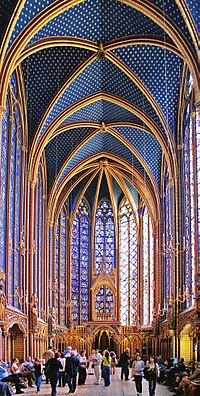
Back Лъчиста готика Bulgarian Gòtic radiant Catalan Gótico radiante Spanish Gothique rayonnant Estonian گوتیک شعاعسان Persian סגנון גותי קורן HE Rayonnant Italian レイヨナン式 Japanese Rayonante gotiek Dutch Styl promienisty Polish
Rayonnant was a very refined style of Gothic Architecture which appeared in France in the 13th century. It was the defining style of the High Gothic period, and is often described as the high point of French Gothic architecture. [1] French architects turned their attention from building cathedrals of greater size and height towards bringing greater light into the cathedral interiors and adding more extensive decoration. The architects made the vertical columns and supports thinner, made extensive use of pinnacles and moldings. They combined the triforium gallery and the clerestory into single space and filled it with stained glass. They made extensive use of moldings and bar tracery to decorate the exteriors and interiors.[2]
The most prominent features of the Rayonnant style were the enormous rose windows installed in the transepts and facades, made possible by the use of bar tracery. The design of the windows gave the name Rayonnant ("Radiant") to the style. [3]
The first major church built in the new style was Amiens Cathedral (1220-1271). Later examples include Sainte-Chapelle, the royal chapel of King Louis IX of France (1248); the new north and south transepts of Notre Dame de Paris (1250-1270, and the church of Sainte-Urbaine in Troyes (1262).[4]
Rayonnant cathedrals soon appeared outside of France. One of the first was Cologne Cathedral. Its choir was built from 1248 to 1322, the decoration accomplished and partly remodeled until 1360. After an interruption from 1528 to 1832, the Cathedral was completed in 1880. The footplan with all foundations is medieval, but many details of the western parts are creations of the 19th century.
The style also soon appeared in England, where it took the name of Decorated Gothic At first French Rayonnant tracery was incorporated into more traditional English features, such as colonettes and vault ribs.[5][6] Notable examples of Rayonnant in England include the Angel Choir of Lincoln Cathedral, and that of Exeter Cathedral (begun before 1280). The striking retrochoir of Wells Cathedral (begun before 1280), the choir of Saint Augustine at Bristol Cathedral, and Westminster Abbey are other important examples.[7]
After the mid-14th century, Rayonnant was gradually replaced by the even more lavishly decorative Flamboyant style.
- ^ "Encylclopaedia Britannica" on-line, ""Rayonnant" (by subscription) retrieved April 2024
- ^ "Encylclopaedia Britannica" on-line, ""Rayonnant" (by subscription) retrieved April 2024
- ^ "Encylclopaedia Britannica" on-line, ""Rayonnant" (by subscription)
- ^ "Encylclopaedia Britannica" on-line, ""Rayonnant" (by subscription)
- ^ Rayonnant Style at the Encyclopædia Britannica
- ^ Gothic art at the Encyclopædia Britannica
- ^ Cite error: The named reference
Lgothiquewas invoked but never defined (see the help page).
